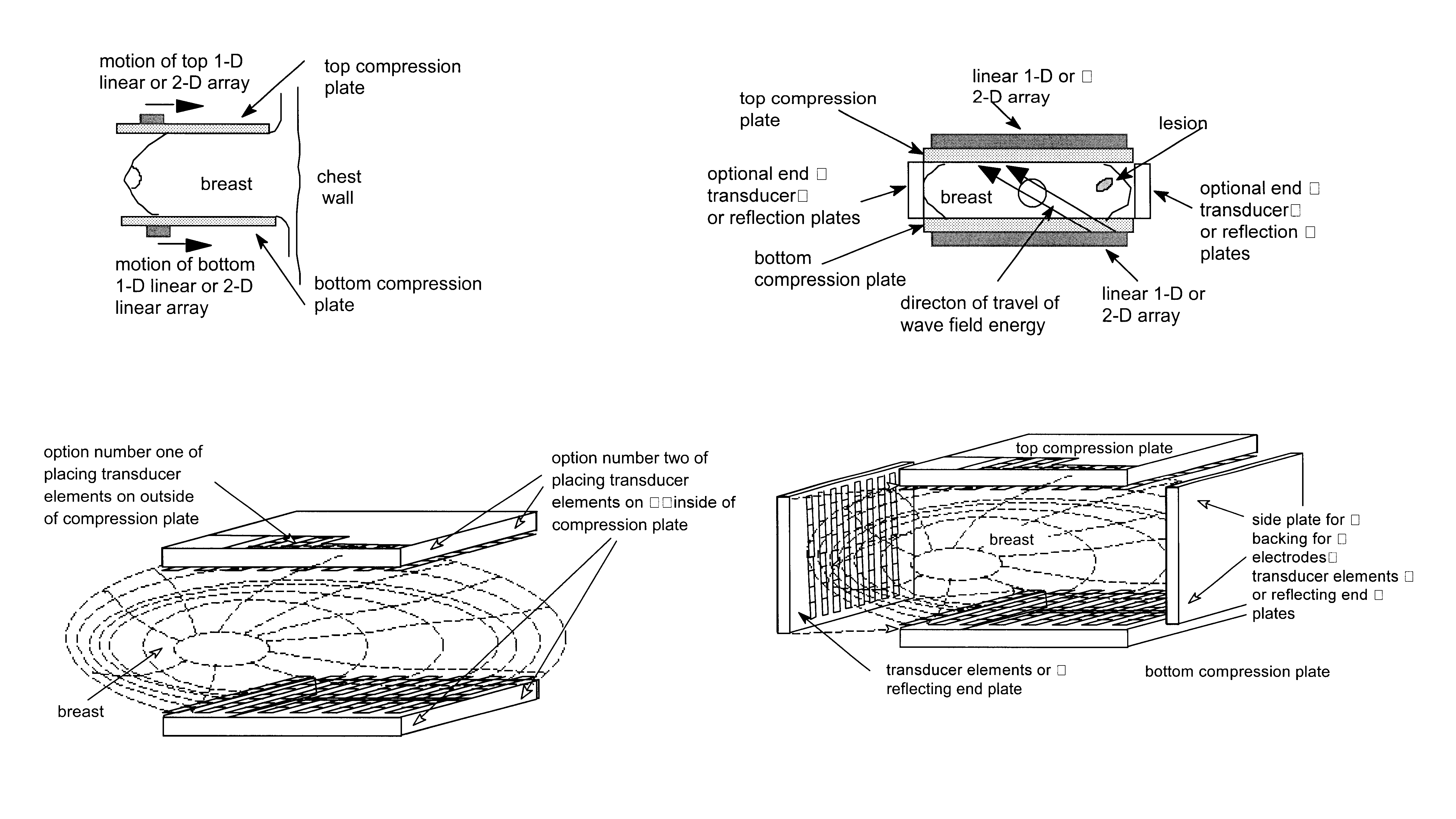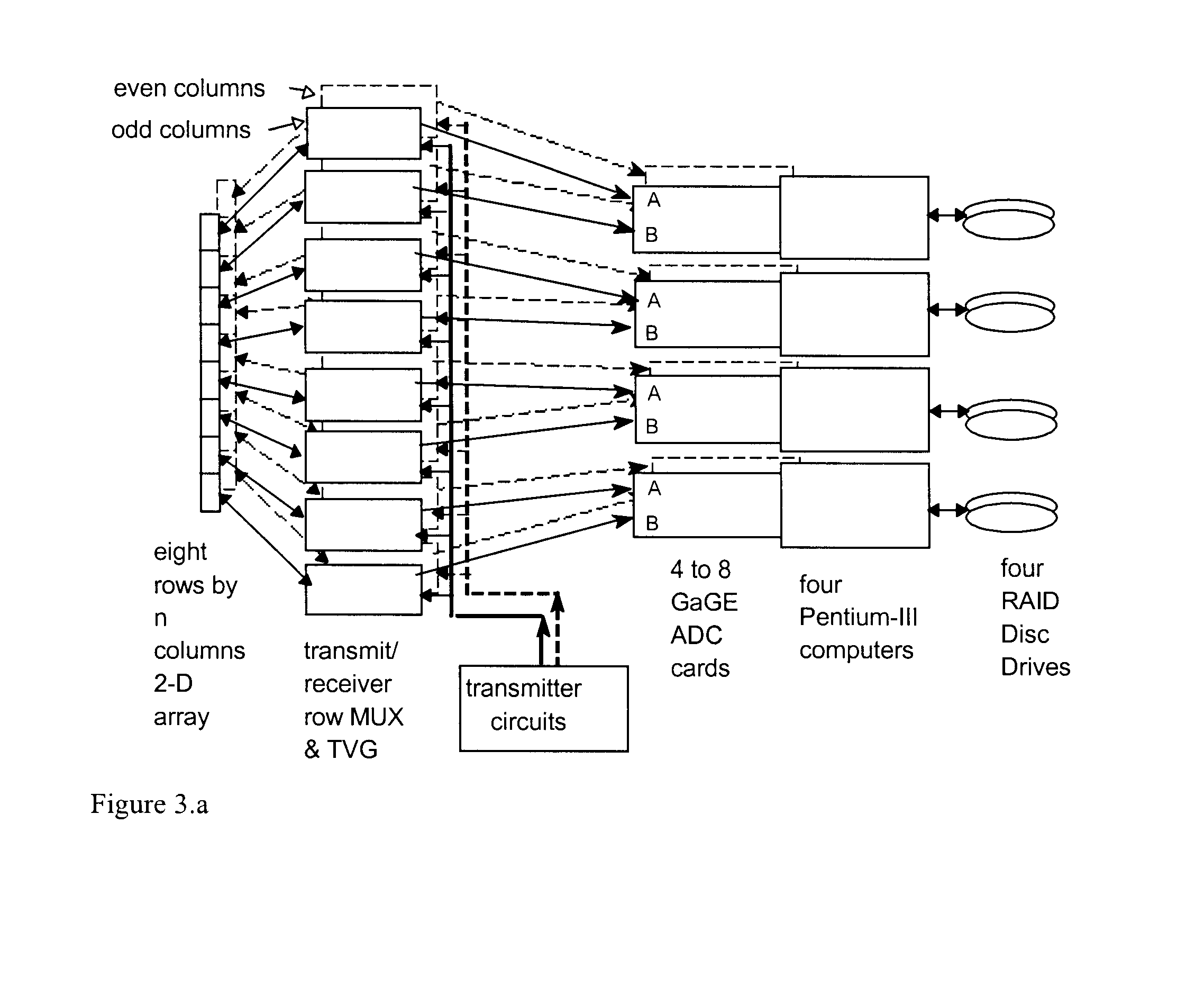Apparatus and method for imaging objects with wavefields
a wavefield and object technology, applied in the field of apparatus and method for imaging objects with wavefields, can solve the problems of traumatic patient biopsy, ten-times more expensive biopsy, and high cost of mammograms
- Summary
- Abstract
- Description
- Claims
- Application Information
AI Technical Summary
Problems solved by technology
Method used
Image
Examples
example 1
Conclusion for Example 1
The original parabolic method used .lambda. / 2 pixels. With 2.lambda. pixels, there are 4.times.4=16 times less pixels, 4 times fewer views and 4 times the inner loop speed, for a factor of 4.sup.4 =256. Changing integral equations from .lambda. / 4 to 2.lambda. pixels, the speed up is 8.times.8 less pixels and 8 time fewer views (the inner loop does not change significantly) for a factor of 8.sup.3 =512. But the old .lambda. / 2 parabolic is 500 time faster than the 1 / 4 integral equation algorithm; the new parabolic wins. At 5 MHz the 2.lambda. pixel spatial resolution is 0.6 mm. With the new parabolic method two options still exist: (1) use .lambda. / 2 or .lambda. pixels and run the imaging program over night for those slices that are wanted at 0.3 mm spatial resolution; or (2) increase computing power. By Moore's law, computing speed increases 2.5 times per 2 years, so in about 12 years 0.3 mm resolution will be standard.
Example 2
Inverse scattering images from r...
example 2
Conclusion for Example 2
The new fast algorithm has been tested in adverse conditions with poor data from the laboratory (real data!) and performs better than the "gold standard" time of flight CT algorithm. Its predicted performance should be about 10 timers better when using data that is designed to meet it's computational and interface requirements . This will be verified in the next two examples.
Example 3
Inverse scattering images from simulated data from 1 / 4 inch Pamametrics video scan transducers using parabolic wave equation.
For this computer simulation example we use the following parameters: Frequency=5 MHz. Number of frequencies=1. Pixel dimension=21 Image size 100 by 100 pixels=2.36 by 2.36 inches. Element aperture=0.236 inches. 90 element translation positions for 90 view angles. Speed of sound values (m / s): cwater=1500, cskin=1505, cfat=1490, cparenchyma=1505, ctumor=1510. The image size can easily be doubled or beyond for real data, The results of this simulation are sho...
example 3
Conclusion for Example 3
Using an accurate model of the two, 5 MHz, 1 / 4 inch diameter piston transducers rather than lab data that was not design ed with the transducers accurately aligned and calibrated, the spatial resolution is about 4 times better than the lab data. In fact, the images are remarkable. This simulation experiment suggest a follow up simulation experiment where a much larger receiver aperture is used to sample a much greater part of the scattered (diffracted) waves in the forward direction. In this case an additional factor of improvement should be obtained. This experiment is performed in the next example.
Example 4
Images made from simulated data for the same phantom as in EXAMPLE 3, but with the 1 / 4 inch diameter piston transducer replace with an transducer array of 120 elements, each 2 wavelength in width and separation.
See FIGS. 8a-8c for the comparison of the time of fight image using CT algorithm with straight acoustic rays vs. the new, high speed inverse scatt...
PUM
| Property | Measurement | Unit |
|---|---|---|
| frequencies | aaaaa | aaaaa |
| frequency | aaaaa | aaaaa |
| collection time | aaaaa | aaaaa |
Abstract
Description
Claims
Application Information
 Login to View More
Login to View More - R&D
- Intellectual Property
- Life Sciences
- Materials
- Tech Scout
- Unparalleled Data Quality
- Higher Quality Content
- 60% Fewer Hallucinations
Browse by: Latest US Patents, China's latest patents, Technical Efficacy Thesaurus, Application Domain, Technology Topic, Popular Technical Reports.
© 2025 PatSnap. All rights reserved.Legal|Privacy policy|Modern Slavery Act Transparency Statement|Sitemap|About US| Contact US: help@patsnap.com



